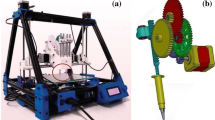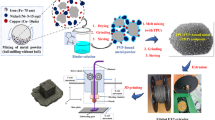Abstract
Additive manufacturing (AM), also known as 3D printing is a manufacturing technology that takes the information from a computer-aided design (CAD) and builds parts in a layer-by-layer style. Further to the extensive research on 3D printing of polymers and metals, ceramics have attracted the increasing attention of researchers, in sectors such as aerospace, electrical, chemical, or medical. Complex shapes printing with porous structures, which are required in the medical area for prostheses, are difficult with most of the traditional manufacturing processes. However, additive manufacturing processes can achieve such geometries. Specifically, the direct ink writing (DIW) process is one of the most promising and inexpensive techniques for shaping free-form ceramic components. In this process, the material is extruded through a syringe and then deposited on a printing bed. In the present paper, the redesign of an extrusion head for ceramics is presented. The main disadvantage of the original design was the limited volume of the syringe vessel barrel. For this reason, the proposed new system has higher capacity. For that, first, the target specifications of the new extrusion system for larger material quantities were defined. For this purpose, the quality function deployment method was used, in order to assure the required quality from the design phase. Then, these critical features and specifications were used to generate the different concepts that will ensure the quality of the printed parts when printing large volumes. The morphological matrix was used in this case. The work presented in this paper is the starting point of the development of the final design of an innovative extrusion head.





Similar content being viewed by others
References
Chen Z, Li Z, Li J, Liu C, Liu C, Li Y, Wang P, Yi H, Lao C, Yuelong F (2019) 3D printing of ceramics: a review. J Eur Ceram Soc. https://doi.org/10.1016/j.jeurceramsoc.2018.11.013.10.1016/j.jeurceramsoc.2018.11.013
Gonzalez GJ, Cano S, Schuschnigg S, Kukla C, Sapkota J, Holzer C (2018) Additive manufacturing of metallic and ceramic components by the material extrusion of highly-filled polymers: a review and future perspectives. Materials 11(5):840. https://doi.org/10.3390/ma11050840
ISO/ASTM 52900 (2015) Additive manufacturing-general principles-terminology. https://www.iso.org/standard/69669.html/. Accessed 10 January 2020.
Marcus HL, Beaman JJ, Barlow JW, Bourell DL (1990) Solid freeform fabrication. Powder processing.
Sachs E, Cima M, Cornie J (1990) Three-dimensional printing: rapid tooling and prototypes directly from a CAD model. CIRP Ann 39:201–204. https://doi.org/10.1016/S0007-8506(07)61035-X
Yan Q, Dong H, Su J, Han H, Song B, Wei Q, Shi (2018) A review of 3D printing technology for medical applications. Engineering. 4:729–742. https://doi.org/10.1016/j.eng.2018.07.021
Paul GM, Rezaienia A, Wen P, Condoor S, Parkar N, King W (2018) Medical applications for 3D printing: recent developments. Mo Med 115:75–81
Corral IB, Rojo OP, Bagheri A, Canel JM (2017) Modelling of porosity of 3D printed ceramic prostheses with grid structure. Manufacturing Engineering Society International Conference, MESIC 2017, Vigo (Pontevedra), Spain. https://doi.org/10.1016/j.promfg.2017.09.183
Kim SH, Shin WB, Baek SW, Yoon JS (2019) Semiautomated fabrication of a custom orbital prosthesis with 3-dimensional printing technology. J Prosthet Dent 122:494–497. https://doi.org/10.1016/j.prosdent.2019.03.021
Ventola CL (2014) Medical applications for 3D printing: current and projected uses. MediMedia USA, Inc 39:704-711.
Elahinia MH, Hashemi M, Tabesh M, Bhaduri SB (2012) Manufacturing and processing of NiTi implants: a review. Prog Mater Sci 57:911–946. https://doi.org/10.1016/j.pmatsci.2011.11.001
Bomze D, Ioannidis A (2019) 3D-printing of high-strength and bioresorbable ceramics for dental and maxillofacial surgery applications-the LCM process. Ceram Appl 7:38–43
Derby B (2015) Additive Manufacture of Ceramics Components by Inkjet Printing. Engineering. https://doi.org/10.15302/J-ENG-2015014
Zhou Z, Cunningham E, Lennon A, McCarthy HO, Buchanan F, Dunne N (2018) Development of three-dimensional printing polymer-ceramic scaffolds with enhanced compressive properties and tuneable resorption. Mater Sci Eng C. https://doi.org/10.1016/j.msec.2018.08.048
Qian B, Shen Z (2013) Laser sintering of ceramics. J Asian Ceramic Soc 1:315–321. https://doi.org/10.1016/j.jascer.2013.08.004
Gu D, Wang H, Chang F, Dai D, Yuan P, Hagedorn YC, Meiners W (2014) Selective laser melting additive manufacturing of TiC/AlSi10Mg bulk-form nanocomposites with tailored microstructures and properties. Phys Procedia 56:108–116. https://doi.org/10.1016/j.phpro.2014.08.153
Sing SL, Yeong WY, Wiria FE, Tay BY, Zhao Z, Zhao L, Tian Z, Yang S (2017) Direct selective laser sintering and melting of ceramics: a review. Rapid Prototyp J 23:611–623. https://doi.org/10.1108/RPJ-11-2015-0178
Griffin C, Daufenbach J, McMillin S (1994) Desktop manufacturing: LOM vs pressing. Am Ceram Soc Bull 73:109–113
Ghazanfari A, Li W, Leu MC, Hilmas GE (2016) A novel extrusion-based additive manufacturing process for ceramic parts. Proceedings of the SFF Symposium, Austin, pp 1509–1529.
Händle F (ed) (2007) Extrusion in ceramics, engineering materials and processes. https://doi.org/10.1007/978-3-540-27102-4
Amza C, Zapciu A, Popescu D (2017) Paste extruder-hardware add-on for desktop 3D printers. Technologies. 5. https://doi.org/10.3390/technologies5030050
Li W, Ghazanfari A, Leu MC, Landers RG (2017) Extrusion-ondemand methods for high solids loading ceramic paste in freeform extrusion fabrication. Virtual Phys Prototyp. 12: 193–205. https://doi.org/10.1080/17452759.2017.1312735
(2012) Universal Paste Extruder for 3D printers. https://www.thingiverse.com/thing:20733. Accessed 10 January 2020.
Pusch K, Hinton TJ, Feinberg AW (2018) Large volume syringe pump extruder for desktop 3D printers. HardwareX. 3:49–61. https://doi.org/10.1016/j.ohx.2018.02.001
Vojtech L (2015) Conception, design and materialisation of a pumping-based extrusion system for food 3D-printing. Polytechnic University of Catalonia: School of Industrial Engineering Department of Mechanical Engineering. Project Report.
Ertay T, Büyüközkan G, Kahraman C, Ruan D (2005) Quality function deployment implementation based on analytic network process with linguistic data: an application in automotive industry. J Intell Fuzzy Syst 16:221–232
Kamara JM, Anumba CJ (2001) ClientPro: a prototype software for client requirements processing in construction. Adv Eng Softw 32:141–158. https://doi.org/10.1016/S0045-7949(00)00142-5
Abdul-Rahman H, H, Kwan CL, Woods PC (1999) Quality function deployment in construction design: application in low-cost housing design. International Journal of Quality & Reliability Management. https://doi.org/10.1108/02656719910268198
Charteris W (1993) Quality function deployment: a quality engineering technology for the food industry. Int J Dairy Technol 46:12–21. https://doi.org/10.1111/j.1471-0307.1993.tb00852.x
Swackhamer R (1985) Responding to customer requirements for improved frying system performance. Food Technol 49:151–152
Vongvit R (2015) Using the fuzzy-QFD for product development: a case study for 3D printer. Appl Mech Mater 789-790:1196–1200. https://doi.org/10.4028/www.scientific.net/AMM.789-790.1196
Caligiana G, Liverani A, Francia D, Frizziero L, Donnici G (2017) Integrating QFD and TRIZ for innovative design. J Adv Mech Des Syst Manuf 11:JAMDSM0015–JAMDSM0015. https://doi.org/10.1299/jamdsm.2017jamdsm0015
Efstathiadis A, Koidis C, Tzetzis D Kyratsis P (2018) Comparative study and analysis on the mechanical properties of 3D printed surgical instrument for in-space applications. Academic Journal of Manufacturing Engineering 16(4):26–32
Cordeiro EC, Barbosa GF, Trabasso LG (2016) A customized QFD (quality function deployment) applied to management of automation projects. Int J Adv Manuf Technol 87:2427–2436. https://doi.org/10.1007/s00170-016-8626-0
Sousa-Zomer TT, Miguel PAC (2017) A QFD-based approach to support sustainable product-service systems conceptual design. Int J Adv Manuf Technol 88:701–717. https://doi.org/10.1007/s00170-016-8809-8
Ulrich KT, Eppinger SD (2011) Product design and development, fifth edn. McGraw-Hill Education
Kasaei A, Abedian A, Milani AS (2014) An application of quality function deployment method in engineering materials selection. Mater Des 55:912–920. https://doi.org/10.1016/j.matdes.2013.10.061
EL Mesbahi J, Rechia A, EL Mesbahi A, Kojmane A (2018) Proposed design process of a customized educational hybrid prototyping machine, Proceeding of 5th International IEEE Congress on Information Science and Technology, Marrakech, Morocco, pp 342-347
Zimmerman J, Evenson S, Forlizzi J (2004) Discovering and extracting knowledge in the design project. In Proceedings of Future Ground. Design Research Society.
Dym CL (1994) Teaching design to freshmen: style and content. J Eng Educ 83:303–310. https://doi.org/10.1002/j.2168-9830.1994.tb00123.x
Pahl G, Beitz W, Feldhusen J, Grote KH (2007) Engineering design-a systematic approach. https://doi.org/10.1007/978-1-84628-319-2
Khandani S (2005) Engineering design process. Education Transfer Plan.
Bettencourt L, Ulwick AW (2008) The customer-centered innovation map. Harvard Business Review.
Kiran DR (2016) Total Quality Management: key concepts and case studies, 1st edn. Butterworth-Heinemann
Arciszewski T (2018) Morphological analysis in inventive engineering. Technol Forecast Soc Chang 126:92–101. https://doi.org/10.1016/j.techfore.2017.10.013
Pugh S (1991) Total design: integrated methods for successful product engineering. Addison-Wesley Publishing Company, Wokingham
Chan LK, Wu ML (2002) Quality function deployment: a literature review. Eur J Oper Res 143:463–497. https://doi.org/10.1016/S0377-2217(02)00178-9
Temponi C, Yen J, Tiao WA (1999) House of quality: A fuzzy logic-based requirements analysis. Eur J Oper Res 117:340–354. https://doi.org/10.1016/S0377-2217(98)00275-6
Bolar AA, Tesfamariam S, Sadiq R (2017) Framework for prioritizing infrastructure user expectations using quality function deployment (QFD). Int J Sustain Built Environ 6:16–29. https://doi.org/10.1016/j.ijsbe.2017.02.002
Ullman DG (2010) The mechanical design process, Fourth edn. Engineering Books.
Bahill AT, Chapman WL (1993) A tutorial on quality function deployment. Eng Manag J 5:24–35. https://doi.org/10.1080/10429247.1993.11414742
Govers CPM (1996) What and how about quality function deployment (QFD). Int J Prod Econ 46-47:575–585. https://doi.org/10.1016/0925-5273(95)00113-1
Akao Y (1900) Quality function deployment: integrating customer requirements into product design-international economy, first edn. Productivity Press
(2012) BRIEF, PRODUCT “Quality function deployment”: Creative Industries Research Institute.
Guidelines for Printing with Thick Paste Extruder (2018) ZMorph Knowledge Base. http://support.zmorph3d.com/hc/en us/articles/115002218985-Guidelines-for-Printing-with-Thick-Paste-Extruder. Accessed 23 December 2019.
Arnone L (2014) Designing a ceramic printhead for a RepRap 3-D printer. Swarthmore College Department of Engineering. Project Report, Swarthmore
(2018) Delta WASPclay 3D printer lets you print high quality ceramic parts with ease. http://www.3ders.org/articles/20180130-delta-waspclay-3d-printer-lets-you-print-high-quality-ceramic-parts-with-ease.html. Accessed 30 December 2019.
ZMorph Thick Paste Extruder. https://www.reprap.me/zmorph-thick-paste-extruder.html. Accessed 30 December 2019.
Acknowledgments
The authors thank Ramón Casado-López for his help with the experimental tests of the ceramic printer.
Author information
Authors and Affiliations
Corresponding author
Ethics declarations
Conflict of interest
The authors declare that they have no conflict of interest.
Additional information
Publisher’s note
Springer Nature remains neutral with regard to jurisdictional claims in published maps and institutional affiliations.
Rights and permissions
About this article
Cite this article
EL Mesbahi, J., Buj-Corral, I. & EL Mesbahi, A. Use of the QFD method to redesign a new extrusion system for a printing machine for ceramics. Int J Adv Manuf Technol 111, 227–242 (2020). https://doi.org/10.1007/s00170-020-05874-x
Received:
Accepted:
Published:
Issue Date:
DOI: https://doi.org/10.1007/s00170-020-05874-x




